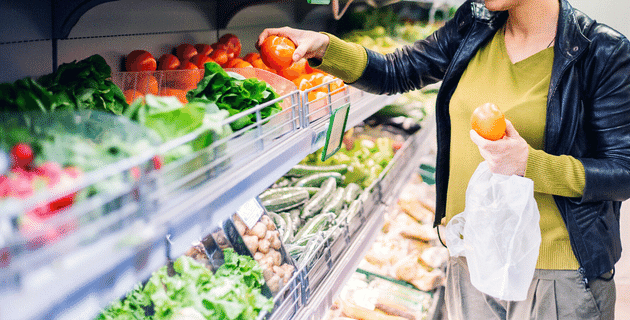If your bill at the grocery store is higher than you’d like, you’re not alone. The average cost of groceries is 13% higher than this time last year. A family of four can spend as much as $932 on their monthly food bill…
Fortunately, there’s something you can do about it. From how you pay for groceries to where and when you shop, here are our top tips for saving money on groceries and feeding your family on a budget.
1. Redefine dinner.
Who says that dinner has to be a three-course affair with meat, veggies, a starch, and a dessert? Take the pressure off and serve breakfast for dinner a few times a week. Omelets are a relatively inexpensive meal and very filling. You also can have soup and sandwich night or a big salad. Be creative. Try going meatless to save money or adding beans to ground beef to increase the amount of food. Put shredded chicken over a soup, salad, or pasta and you’ll use a lot less than when serving pieces of chicken.
Pro Tip: Plan to cook so that you definitely will have leftovers. It’s easier and often cheaper to make a large portion than to plan a whole new meal with new ingredients.
2. Make a list and actually stick to it.
Make a meal plan for the week so you know exactly what to put on your shopping list. Pre-planning cuts down on impulse purchases, which can put you over budget. Then shop only for those items on your list. To help stick to your list, always make sure to eat before shopping,
3. Raid your pantry.
When meal planning, remember that you likely have plenty of food at home that you can incorporate. Look through your pantry and see if you can create a recipe around the food that is there. Check your freezer too. That way, you may just need a few items on your list to create some delicious meals.
Pro Tip: Check out websites that can help you build a recipe with ingredients that you already have like MyFridgeFood or SuperCook.
4. Sign up for the store’s loyalty program.
Most grocery stores offer loyalty programs that are free to join. You can get discounts automatically deducted at checkout. If you’re not on your store’s program, sign up the next time you’re there.
5. Clip coupons and look for sales.
Look at the weekly circular in print or digitally for sales, and clip/save coupons for the items you use. Digital coupons can even be loaded directly onto your loyalty card. Remember to do the math, however. Not all sales are the same good deal. Look at the unit price per ounce to compare the costs of different brands. Plus, if you’re not sure that you’ll use it, don’t buy it. Spoiled fruit in the garbage is the same as throwing away money.
6. Buy store brands.
The cost of store brands is usually 20-25% less. Try them out next time and see if you notice enough of a difference to justify buying the name brand. If you can’t buy all generic brands, at least try store brands for staples like salt and sugar.
7. Avoid pre-made items.
Convenience comes at a price. That means if something is prepared for you, you’re likely paying more for it. When you’re shopping, try to find food closest to its natural state. Buy block cheese instead of shredded cheese, and a box of pasta rather than a heat-and-eat variety. Snacks are some of the priciest items to buy. You can really save a lot here if you prepare them yourself.
8. Tally as you go.
Use the calculator on your phone to add up your order as you shop. You’ll be less likely to add items this way, and there will be no surprises when you get to the checkout. It might cause you to think, “do I really need this?”
9. When you shop matters.
Shop midweek when many grocery stores restock their shelves. That’s also when they change the discounts. If you’re lucky, you’ll get the price cut from last week’s sale. If you’re looking for clearance specials, shop first thing in the morning – or right after a holiday. If you’re looking for specials in the bakery, deli, or prepared foods section, shop right before closing. Many supermarkets mark down their rotisserie chickens, for example.
10. Pay with a rewards credit card or cash.
You might as well get some cash back when you shop. Pay with a grocery rewards card and you can automatically see some savings. Or if you can, pay with cash. Bring only the amount you want to spend, and when the cash runs out, you can’t buy anything else.
11. Compare prices at different stores.
Compare prices at different nearby grocery stores. Switch to a store that’s known for more affordable food prices like Walmart, Aldi, or Trader Joe’s. Even Dollar Tree has grocery items. Or you can join a wholesale club like Costco or Sam’s Club. These stores stock items in bulk at often lower prices. You’ll have to spend more upfront but you’ll save in the long run. That might not be for everyone but it’s a good value for large families.
12. Use a rebate app.
Sign up for apps like Ibotta and Rakuten. They give you cash back for buying groceries, among other items. Stores pay these apps a commission for sending them your way. Find out which apps link to your grocery store to make sure that they are an affiliate partner.
Happy shopping!
This article is furnished by California Casualty, providing auto and home insurance to educators, law enforcement officers, firefighters, and nurses. Get a quote at 1.866.704.8614 or www.calcas.com.
- Graduation – When to Remove Your Child from Your Auto Policy - May 18, 2023
- How to Prevent Catalytic Converter Theft - May 17, 2023
- How Much Does Home Insurance Cost? - May 17, 2023

